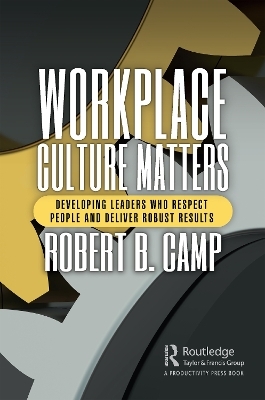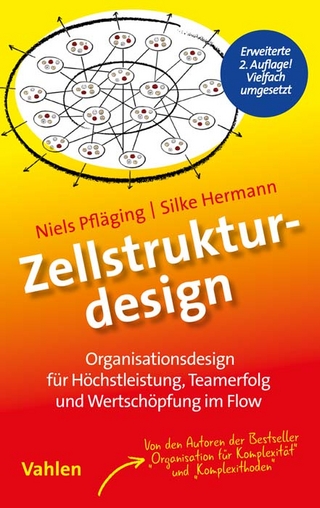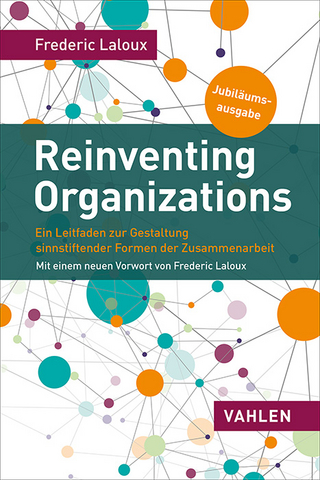
Workplace Culture Matters
Productivity Press (Verlag)
978-1-032-37254-9 (ISBN)
Written in a novel format, this book addresses the challenge of changing a "sick" culture.
Some organizations wake up one day and realize they have become something they never intended. Their employees run scared. There is no innovation, only blind obedience. There are warlords within the ranks of management, and they fight over turf without considering the best interests of customers, their employees, or their organization as a whole.
At the Charleston, SC, branch of Copper-Bottom Insurance, the wakeup call comes when an employee files a lawsuit against the company and its leaders. The Charleston division Vice President, Jack Simmons, is put on probation and given an ultimatum: "Change the culture!" Jack understands the "or be fired" implication all too well. He scrambles to find help and runs into an old friend, Don Spears, from Friedman Electronics. With Don’s help, Jack begins the journey that will heal his organization.
In the course of their first visit, Don and his Director of Continuous Improvement, Tim Stark, help Jack to make an important discovery: Copper-Bottom’s executives are not showing their people respect. Don and Tim point to the following observations as proof. Copper-Bottom leaders are
Using top-down, "command-and-control" leadership behaviors rather than recognizing their people as Subject Matter Experts and listening to them
Issuing instructions to their people rather than observing then improving performance through coaching
Keeping employees in the dark as to the impact their work has on the organization’s mission
Unaware of the obstacles in their people’s paths; hence, never using the authority of their positions to remove those obstacles
Staying in their offices, aloof to the difficulties their subordinates face
As Don and Tim see it, Copper-Bottom’s problems stem from the way its leaders lead. After the executive who precipitated the lawsuit is let go, the Friedman team begins the process of teaching Copper-Bottom’s executives that a healthy culture begins at the leadership level. Don, Friedman’s General Manager, states that cultures change when their leaders change. In short, leaders need to initiate the changes in the culture by first demonstrating the desired behavior. So begins the process of reeducating Copper-Bottom’s leaders in the difference between managing and leading.
In short order, Tim begins to work with Jack’s leadership team while Don takes Jack to Friedman’s Oakland facility. There Jack learns
To first concentrate on surrounding himself with the right people
The importance of top-down metrics to which leaders first hold themselves accountable
Cascading their metrics (KPIs) down through their organization and using a dialog about them as a way of developing relationships of respect
Although a long way from complete, by the end of Jack’s six-month probation, Copper-Bottom has made significant strides and is well on its way to changing its culture. Jack will learn that he is not the only one to appreciate the new developments.
A graduate of the US Military Academy at West Point, Robert Camp began his career in one of this country’s foremost schools of leadership. Yet, like most, he gained his real impression of the skill by watching leaders. He came to realize that leadership is a precious gift that far too many fail to recognize. In the mid-1980s, as Americans began to watch markets they had created be penetrated, then dominated by Japan, Robert started reading the literature trickling out of that country. Each new book pointed to a new technique. "Statistical process control (SPC) is how they’re doing it!" proclaimed some. "It’s quality circles," countered others. Still others claimed it was just-in-time (JIT) manufacturing. As it turned out, none was right; all were right. Over time, as a more complete picture formed, Robert learned that it was the combination of those tools that gave the Japanese their considerable edge. Still, the picture was not quite complete, and it wasn’t until the late 1990s that the world came to realize that the tools alone would never make an organization Lean, because their results couldn’t be sustained. By then, Robert had made Lean a full-time profession. Over and over he transformed organizations. Some succeeded, but most failed. He tried to make heads or tails of the circumstances that made the difference. The answer, he discovered, was right under his nose all the time. The difference was leadership. He learned that many have been content to manage and call it leadership. Management, however, isn’t leadership. In fact, it’s a far cry from there. Management faces backward, analyzing yesterday’s data and perfecting it today. It’s an extremely valuable skill, and much-needed, but it’s not leadership. Leadership, as Robert sees it, is the ability to look forward, over the horizon and through the haze of battle, to define, then communicate, a new course of action and compel others to follow. Robert has had the good fortune to work for some of this country’s biggest and most successful organizations. Throughout his career, he’s been afforded the privilege of working under great men and women who have taught him both in word and deed.
About the Author. Introduction. Chapter 1 The Last Straw. Chapter 2 Legal Hot Water. Chapter 3 Unraveling the Ball of Twine. Chapter 4 What Goes Around … Chapter 5 Any Port in a Storm. Chapter 6 Monday: Starting from the Ground Up. Chapter 7 Tuesday: The Work Begins. Chapter 8 Wednesday: The Tide Shifts. Chapter 9 Thursday: "All In!" Chapter 10 Friday: A Long, Long Day. Chapter 11 The Plan. Chapter 12 Monday: A New Leaf. Chapter 13 Monday Continued: Clearing the Air. Chapter 14 Tuesday: Take Two. Chapter 15 Leading from the Top. Chapter 16 California or Bust. Chapter 17 Oakland. Chapter 18 First Who. Chapter 19 Another Bite of the Apple. Chapter 20 A Lot to Cogitate. Chapter 21 Thursday: Drilling Deeper. Chapter 22 Out of the Blue. Chapter 23 Dialog as a Way of Coaching. Chapter 24 A Slight Hiccup. Chapter 25 Closings and Coaching. Chapter 26 Change at Last. Chapter 27 Walking. Chapter 28 Finally, a Break. Chapter 29 Our Best Selves. Chapter 30 The Map to Success. Chapter 31 An Illogical Flow. Chapter 32 Unkinking the Hose. Chapter 33 Confrontation. Chapter 34 The Turning Point. Chapter 35 A Second Start. Chapter 36 Truly Leading. Chapter 37 Standard Work and Water Spiders. Chapter 38 Putting It All Together. Chapter 39 Winning Back Time. Chapter 40 Acknowledging Values. Chapter 41 Leader Standard Work. Chapter 42 Objective Performance Evaluation. Chapter 43 Coaching the Middle. Chapter 44 Tim and Patty. Chapter 45 That’s a Wrap! Index.
| Erscheinungsdatum | 06.12.2022 |
|---|---|
| Verlagsort | London |
| Sprache | englisch |
| Maße | 152 x 229 mm |
| Gewicht | 600 g |
| Themenwelt | Technik ► Umwelttechnik / Biotechnologie |
| Wirtschaft ► Betriebswirtschaft / Management ► Planung / Organisation | |
| Wirtschaft ► Volkswirtschaftslehre | |
| ISBN-10 | 1-032-37254-0 / 1032372540 |
| ISBN-13 | 978-1-032-37254-9 / 9781032372549 |
| Zustand | Neuware |
| Informationen gemäß Produktsicherheitsverordnung (GPSR) | |
| Haben Sie eine Frage zum Produkt? |
aus dem Bereich


